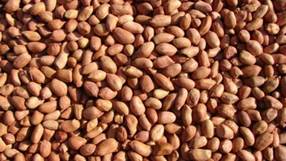Groundnuts
Varieties
2.1. Environmental Requirements
2.1.1. Altitude and latitude
- Grow well within latitude range of 500 North and South of Equator.
- It grows well within areas of about 1000m above sea level.
- However, specific varieties have been developed to suit specific area for maximum results.
2.1.2. Temperature
- Groundnuts is a warm season crop that requires enough sunshine for normal development.
- For optimum results temperature range of 18-25oC is essential.
2.1.3. Rainfall
- Annual rainfall requirement for this crop is about 1000mm or more.
- Half of this should be received during the growing season to be followed by a distinct dry season during which the pods ripen and mature.
2.1.4. Soils
- The crop favors loose, friable sandy soils of poor fertility.
- Well drained sandy loams are the most favorable.
3.0. Improving yields
In order to improve yields the following husbandry practices are recommended:-
3.1. Use of recommended varieties
- Farmers should select and reserve adequate supplies of the recommended varieties for seed. These should be kept in shell until shortly before planting.
- Farmers may obtain seed from ADMARC, Community Seed Banks, Seed Multiplication Action Groups (SMAGs), Associations, NGOs and others.
3.2. Recommended Varieties
3.2.1. Chalimbana
- It is a confectionery nut recommended in all plateau areas with altitude range of 1000-1500m above sea level.
- It has large seed size and often matures within 140-150 days after sowing.

Figure:1 Chalimbana nuts
3.2.2. Chitembana
- Is a confectionery nut with well-shaped seed and larger size than Chalimbana.
- It is recommended in plateau areas as is the case with Chalimbana and maturity is within 140-150 days.
3.2.3. CG7
- Is a confectionary nut with medium seed size.
- Recommended for plateau, lakeshore and Upper Shire Valley areas of the country.
- It matures in 130 to 150 days.
3.2.4. Malimba
- Is a confectionery nut
- Recommended for Shire valley and Lakeshore areas of altitude 200-300m above sea level.
- It matures in 110-120 days.
3.2.5. RG1
- Is a confectionery nut
- Recommended for production in all area where rosette is a problem such as Phalombe.
- Matures in 130 to 140 days.
3.2.6. Mani-pintar
- Is an oil nut
- Recommended in lakeshore areas of Nkhotakota, Salima, Mangochi, Upper shire Valley, Bwanje Valley and Balaka. Such areas are within the latitude of 500-700m above sea level.
- Matures 130-140 days.
3.2.6. Mawanga
- Is an oil nut
- Does much better if grown in areas where mani-pintar is grown.
- It can also grow in plateau areas.
- It is 3% higher in oil content than mani-pintar.
3.2.7. Nsinjiro (ICGV-SM 90704)
- It is a confectionery nut
- Recommended in all plateau areas.
- It is tolerant to Rosette with a potential yield of up to 2000kg/ha.
- Matures within 120-140 days after planting.
3.2.8. Kakoma (JL 24)
- It is a confectionery nut.
- It is recommended for low lying areas of altitude 200-500m above sea level.
- It is good for dimba cultivation (under irrigation).
- It matures around 90-120days.
- It is small seeded with potential yield of up to 1500kg/ha
3.2.9.Baka (ICG 12991)
- It is a confectionery nut
- Recommended for low lying areas and good for dimba cultivation.
- Matures in 90-100days.
- It is bunch type and requires more calcium to avoid pod pops.
